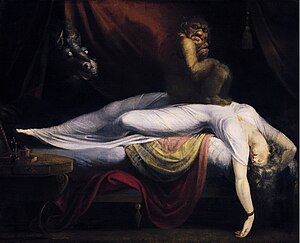THE NIGHT MARE
I am the
night mare.
I neigh
nigh, eager to graze your hair.
Zip, zap,
zoom through the dark site,
My hooves
hover over the sombre night light.
When I
shake my mane and snort for your cue,
I draw in
the sky another scary curlicue
On the screen
of your nocturnal air.
I am your
night mare.
I am the
night mare.
My fiery
eyes flare!
Your most obtuse
phantasms I will peruse.
I will rear
up and muzzle your muse!
I paw your
brain for your wildest dreams,
Fidget
about your mind for your screams
And gallop wherever
you stare.
I am your
night mare.

The Nightmare -- Henry Fuseli
The meaning of mare depends on who is doing the riding. The adult female horse takes its name from the Old English "m(i)ere," while the evil female spirit who rode on the chesats of sleeping people, bringing them bad dreams, takes its name from the Old English "mære" (from the Common Germanic *marōn) and maybe to the Proto-Indo-European *mer- ("to rub away" or "to harm") or to the Indo-European *moros ("death"). The mare also rode horses, leaving them exhausted and covered in sweat. "Marelocks" were caused by her tangling of the hair of sleeping beings, an explanation for the hair disease called "Polish plait" (in which the hair shaft becomes irreversibly entangled, forming a mass which is matted and which may be sticky and moist). She rode trees as well, resulting in entangled branches: the twisted, undersized pines that grow on coastal rocks and wet ground are known in Swedish as "martallar" (mare-pines) and in German as "Alptraum-Kiefer" (nightmare pine). The first literary mentions are Icelandic. In the "Ynglinga" saga written by Snorri Sturluson ca. 1225 (but based on the work of the 9th century skald, Thjodolf [Þjóðólfr] of Hvinir), king Vanlandi Sveigðisson of Uppsala promised his wife to return home within three years, but after a decade of absence she hired the Finnish sorceress Huld (or Hulda) to lure him back or, failing that, kill him; when the king fell asleep, the mara that Huld conjured rode him; when his men held his head, it trod on his legs to the point of breaking them, and when they seized his feet it pressed down on his head and killed him. In the "Vatnsdœla" saga, probably written just after the middle of the 13th century, Thorkel Silver (Þorkell Silfri) dreamed about riding a red mare that barely touched ground, which his wife viewed as a bad omen, insisting that the mare signified a man's fetch (fylgja), an exact, spectral double, and that red meant bloodiness. The "Eyrbyggja" saga was probably written in its entirety in the mid- or late-13th century, though it dealt with events from the 9th to the early 11th centuries; in it, the sorceress Geirrid was accused of assuming the shape of a "marlíðendr" or "kveldriða" (night-rider or ride-by-night) who caused serious trampling bruises on Gunnlaug Thorbjornsson. In Slavic lore, Mora (or Mara) was a dark spirit who took the form of a beautiful woman and then visited people in their dreams, torturing them with desire, and dragging life out of them. To the Poles, the
ReplyDeletezmora (or mara) were souls who left people's bodies at night and looked like hair, wisps of straw, or sphinx moths; they would enter a room through a keyhole, sit on the sleepers' chest, and try to strangle them (hence "moriti," meaning "to torture, bother, or strangle). To repel them, people would turn their pillow and make a sign of cross on it (in the early 19th century, Vuk Karadžić said people would leave a broom upside down behind the door or put their belt on top of their sheet).